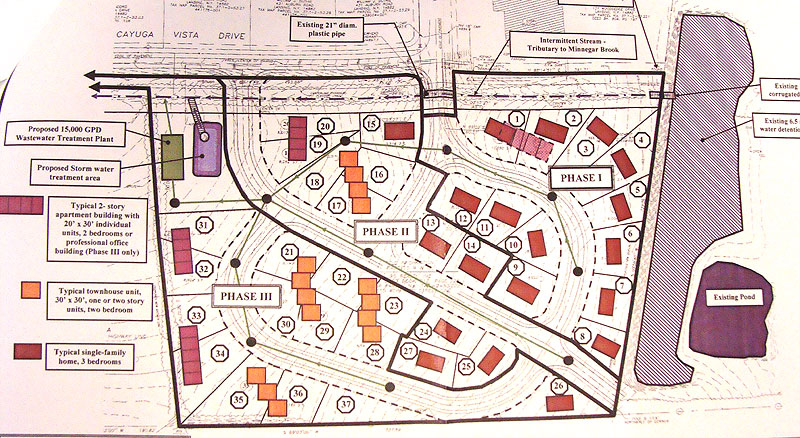- By Dan Veaner
- News
 Print
Print  The Lansing Commons development suffered another delay at the April 15 Town Board meeting when the board was unable to approve a preliminary environmental review and the Planned Development Area (PDA). While board members favor the development they wanted more time to resolve questions on environmental impact and public opposition to a proposed 15,000 gallons-per-day wastewater treatment plant.
The Lansing Commons development suffered another delay at the April 15 Town Board meeting when the board was unable to approve a preliminary environmental review and the Planned Development Area (PDA). While board members favor the development they wanted more time to resolve questions on environmental impact and public opposition to a proposed 15,000 gallons-per-day wastewater treatment plant."This is private property and I am in favor of this project," said Town Councilman Bud Shattuck. "I think that a project on that property is the landowner's right. At the same time, for a project this big, for something we've never done before, that we need to make sure that we're looking at the full environmental impact of it. I think it's premature for us to move forward with approving this without more discussion."
The project proposed by developer Ron Secord south of Woodsedge Drive and Cayuga Vista Drive is planned in three phases that could include about 20 single family homes, three apartment buildings, 15 town houses and possible commercial development. Because of the density of the plan and the fact that sewer is not available, a small sewage treatment plant is proposed in the southeast corner of the development, adjacent to Minnegar Brook.
 pb0209_lansingcommonsplan800.jpg(Click Picture at left for larger version)
pb0209_lansingcommonsplan800.jpg(Click Picture at left for larger version)It is that sewage treatment plant that residents objected to, fearing pollution of the brook and increased costs to town taxpayers. "The outfall from this treatment plant ultimately falls on private property," said Tom Besemer, who lives on Drake Road downstream from the proposed plant. "There is no apparent drain for this lagoon on private property that goes into the lake. There is some seepage and evaporation, but that's it. Wildlife that feeds and nests there. All my employees and my customers work in this area. if it is permanently flooded what are the health risks?"
"My child played in the creek," said Joan Ellis, who owns property adjacent to the brook. "What if there had been E. coli floating down the brook? Basically you're saying that it's OK to have drain water coming down the creek. I don't think that's acceptable."
Planning Board member Tom Ellis also had concerns about the ongoing commitment the Town will incur to provide service, as well as the veracity of the state Department of Environmental Conservation's (DEC) certification of the safety of such sewage plants. Ellis has expressed concerns for months in Planning Board meetings before the Planning Board referred the matter to the Town Board.
"There are going to be problems," he said. "It's a huge sewage system. On the planning board level I and other members have requested information on this system. Where is it being used? How long is it being used? What problems has it had? In what context has it been used? Has anyone in the state actually built a new development with this system?"
Drake Road resident Bill Hinderliter complained that inadequate notification had been sent to residents downstream of the development.
Shattuck noted that in initial talks the DEC indicated they would approve the plant. But he said there were about a dozen unanswered questions that would prevent him from voting for the State Environmental Quality Review (SEQR) if it were to be voted on that night.
But a representative of the developer was concerned about what would happen if the SEQR is not approved, noting that it was town officials that prompted the developer to pursue the PDA path. Deputy Councilwoman Connie Wilcox agreed.
"I think it's unfortunate that the developer was urged to go with the PDA," she said. "It seems like he's had a lot of stalls along the way. We haven't done this before and he's paying the price."
But Shattuck said that is the only way the project could go forward as proposed, explaining that a PDA is for the purpose of allowing something that is not allowed in the zoning ordinance. He said that once the questions are answered satisfactorily he supports the development. "I think the PDA is the right thing to do," he said. "I think it's going to work."
Town officials explained that only those who benefit from the treatment plant would pay for it, and that Lansing taxpayers in general would not be billed. "It's similar to a lighting district," Supervisor Scott Pinney explained. "When a certain group of residents in a location receive water or lighting or sewer, those people in that district will pay a special bill on their taxes to support that."
As the Town Board decided to extend the public hearings until the May 20th meeting, Town Attorney Guy Krogh warned against approving or denying the SEQR based on unknowns. he noted that the current approval is preliminary and that there would be many more stages before the project is actually approved.
"The DEC has not issued a permit," he said. "You don't know if this plant is going to exist and if it exists you don't know where the outfall pipe is going to be. So I'm not sure that this is the stage at which we say we're going to look at everything in Minnegar Brook. To a certain extent there are questions that will come up if you look at this as a final approval that you cannot now answer. Until the DEC issues a permit you're not going to be able to answer them."
The Board adjourned the public hearing for the SEQR until 6:15pm on May 20, and the one for the PDA for 6:20.
----
v5i16



